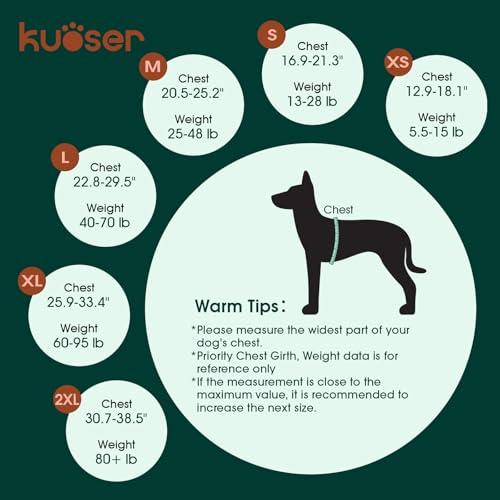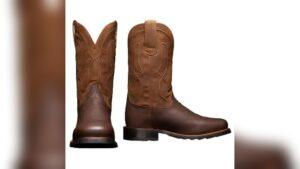Top pick: Kuoser High Flotation Dog Life Jacket — safety, handle, and bright visibility on boats.
I live in the US, in Sarasota, Florida, and I spend most weekends on the water with my Labrador, Scout. I’ve seen the panic of a dog slipping off the swim platform, the relief when a bright, secure dog life jacket brought them right back to the boat, and the quiet confidence a good life vest gives me when casting or cruising. If you boat regularly, especially in coastal waters, lakes, or rivers, the right gear solves one big problem: keeping your dog safe, buoyant, and visible so you can focus on fun instead of fear. That’s why I’ve tested and trusted multiple dog life jackets and why I’m sharing my findings on the best dog life jackets for boating.
Kuoser High Flotation Dog Life Jacket
The Kuoser Dog Life Jacket delivers on the three most important things I look for when boating with a dog: flotation, visibility, and rescue control. The outer shell is a bright neon color with reflective strips that catch light at dusk. The foam flotation panels sit along the chest and belly to help most dogs stay level in the water. The vest uses adjustable straps across the belly and neck, which made fitting Scout snug and secure without choking him. A reinforced, wide rescue handle sits on top. In my tests, that handle simplified lifting a wet dog onto the swim step when waves and a slippery hull made the task awkward.
Material-wise, this jacket balances weight and support. It uses dense foam that keeps the dog afloat but remains lightweight for easy movement. The stitching and buckles held up through a few months of sun, saltwater rinses, and rough play. The fit chart runs true overall, though I did see slightly smaller neck openings on the medium compared to other brands; I solved that by loosening the top straps and trimming loose webbing ends. If you plan long swimming sessions or boating trips, the Kuoser jacket helps reduce fatigue and improves visibility—two key safety wins I value most when I take Scout out on busy waterways.
Pros:
- High flotation foam keeps dogs level and reduces fatigue.
- Bright neon fabric plus reflective strips boost visibility on the water.
- Strong, reinforced rescue handle makes boarding easier.
- Adjustable straps for a secure fit across neck and belly.
- Lightweight design preserves mobility for swimming dogs.
- Durable buckles and reinforced stitching for frequent use.
Cons:
- Neck opening runs slightly small on some sizes—measure carefully.
- Foam panels are firm; dogs new to vests may need time to adapt.
- Limited color options compared to other brands.
My Recommendation
I recommend the Kuoser High Flotation Dog Life Jacket for owners who boat frequently and need a reliable, visible vest that helps lift and control their dog during rescues. It’s best for active breeds, swimmers, and dogs that spend time on swims platforms or small boats. The bright color and reflective trim make it easy to spot a dog even in choppy water. The reinforced handle and durable buckles give me confidence that I can safely help my dog back on board without struggling with flimsy materials.
If you want the best dog life jackets for boating that balance safety, durability, and value, the Kuoser vest is a solid choice. Availability is good most seasons and sizing covers small through large breeds. Always measure chest girth and neck circumference before ordering, and allow the dog a short swim session to get comfortable in the jacket before long outings.
| Best for | Why |
|---|---|
| Active swimmers | Lightweight flotation keeps mobility while boosting safety. |
| Owners who boat often | Reinforced rescue handle and durable buckles ease boarding. |
| Dogs in low-light boating | Neon color and reflective trim improve visibility in dusk conditions. |
Why a Dog Life Jacket Matters When Boating
I’ve learned the hard way that a dog’s swimming ability doesn’t guarantee safety in open water. Currents, fatigue, and cold water can overwhelm even strong swimmers. A life jacket offers buoyancy that keeps the dog afloat while reducing panic. It buys time to get your pet back to the boat, especially in windy or choppy conditions. For anyone in the US who boats on anything from coastal bays to inland lakes, a dog life jacket is not an optional accessory; it’s essential safety gear.
Boating environments are unpredictable. Waves can throw a dog off balance. A sudden swim or a leap after a bird can lead to rapid fatigue. A life jacket supports the dog’s chest and keeps the head up. Reflective trim and bright colors also help other boaters see your pet. Put simply: a life jacket reduces the risk of drowning, speeds rescue, and gives you peace of mind so you can enjoy time on the water.
How I Test Dog Life Jackets for Boating
I test dog life jackets on real outings. I look at fit, buoyancy, material strength, and how easy it is to rescue a dog using the handle. I test in calm and choppy water, with fresh and salt conditions. I assess how jackets affect a dog’s mobility and comfort during play and rest. I also test dry times after rinses and sun exposure to see how fabrics hold up to long-term use.
I use a repeatable checklist: measure fit against manufacturer charts, perform a short supervised swim, simulate a boarding rescue with one person, and check buckles and seams for wear. I also rate ease of cleaning and storage. That hands-on approach helps me recommend reliable options and point out common fit issues owners might face.
Key Features to Look For in the Best Dog Life Jackets for Boating
Buoyancy is the top priority. Look for dense foam panels in the chest and belly area. The best dog life jackets for boating distribute floatation to keep the dog level in the water so its head stays above the surface. Next, search for a strong, reinforced rescue handle. It should let you lift a wet, heavy dog without tearing. Reflective strips and bright colors help with visibility. Adjustable straps across the neck and belly ensure a snug fit that prevents the jacket from slipping off during a swim.
Materials matter. Neoprene offers a comfortable fit close to the body and insulates slightly in cold water. High-density foam gives more buoyancy but can feel firm. Look for robust stitching, corrosion-resistant buckles, and quick-dry liners. Lastly, consider sizing options and weight ranges—measure your dog properly and choose the vest that matches chest girth and weight for the best buoyant support.
Sizing Guide: How to Fit the Perfect Jacket
I always measure three things: neck circumference, chest girth (widest part behind the front legs), and weight. Most brands provide a sizing chart—use that chart. If your dog is between sizes, choose the larger size and adjust straps for a snug fit. Never rely only on “small” or “medium” labels. A properly fitting life jacket should let your dog walk, sit, and swim comfortably. When lifted by the handle, the jacket should support the dog’s chest without causing the head to tip back unnaturally.
Fit tips: place two fingers under the buckles to check for comfort. Make sure the belly strap sits snugly but not tight. The neck opening should not press into the throat. If your dog has a deep chest or broad shoulders, check for vests with wider chest panels. If your dog dislikes a vest, try short acclimation sessions and reward calm behavior to build positive association before longer boat trips.
Materials, Buoyancy, and Comfort Explained
Neoprene jackets feel like wetsuits and hug the body. They are warm and comfortable for cooler water. Foam-filled vests offer higher buoyancy but can be bulkier. Look for closed-cell foam for durability and consistent buoyancy. Mesh liners and quick-dry fabrics help the jacket stay lighter when wet. Also inspect the collar design: some have extended neck support to keep the head above water, which is useful for timid swimmers.
Comfort also comes from design details: padded straps, soft lining under the belly, and rounded edges prevent chafing. Collar depth matters—too high and it restricts head movement; too low and it won’t keep the head up. For long days on the water, choose a design your dog tolerates and doesn’t fight. Balance between buoyancy and mobility is key for the best dog life jackets for boating.
Safety Tips When Boating with Dogs
Always make your dog wear the life jacket whenever off the dock or while the boat is moving. Even in calm lakes, a sudden wave or wake can sweep a dog off their feet. Keep a short, secure boarding ladder or ramp for dogs and practice using the rescue handle so your dog learns to approach the boat for help. Keep emergency gear like a rope throw and a spare life jacket aboard.
Teach basic water recall before long trips. Use positive reinforcement so the dog returns to you or the boat on command. Avoid letting dogs jump off a moving boat where propellers are active. Rinse the jacket in fresh water after saltwater exposure and hang to dry in shade to extend life. Regularly inspect buckles and seams for wear.
Common Fit Problems and Quick Fixes
If the jacket rides up behind the front legs, the belly strap might be too loose or the jacket is too small. Tighten the belly strap or size up. If the neck feels tight, loosen the neck strap and check collar depth. For dogs that complain loudly when first wearing a jacket, try short, positive sessions: put the jacket on for a minute, reward, then extend time gradually. If the dog swims poorly with a very buoyant vest, try a lower-buoyancy design or one with a different chest panel shape.
If buckles chew into fur, shorten loose webbing ends and clip them out of the way. For dogs that shake sand or water into the vest, choose a model with removable foam panels for easy cleaning and drainage. Simple fixes like these make life jackets far more usable over the long term.
Top Use Cases for the Best Dog Life Jackets for Boating
Frequent boaters need durable, highly visible life jackets with strong rescue handles. Kayakers and paddleboarders often choose slimmer, more flexible vests that allow swimming and climbing back onto boards. Dockside swimmers may prefer lightweight foam vests that help dogs rest in deep water without tiring. For cold-water boating, neoprene jackets offer added insulation along with flotation.
If you boat in crowded waterways, visibility and a rescue handle are priorities. If your dog swims for exercise or retrieves toys, look for a vest that balances flotation and range of motion. Matching the vest to your typical activity is the quickest way to pick the best dog life jackets for boating.
Maintenance and Care for Long Life
Rinse the life jacket with fresh water after every saltwater outing. Use a mild soap for stains and surface grime. Avoid high-heat drying or prolonged sun exposure; instead, hang in shade to dry evenly. Inspect straps, buckles, and seams before each trip. Replace the jacket if foam compresses or stitching fails, as buoyancy and safety will be compromised.
Store the jacket in a cool, dry place. Keep it away from solvents or oils that can deteriorate foam and fabric. Rotating two jackets for heavy seasonal use extends life by reducing constant stress on a single vest. Proper care guarantees the jacket remains a reliable tool among the best dog life jackets for boating.
How to Teach Your Dog to Accept a Life Jacket
Start on dry land. Let the dog sniff the jacket and reward curiosity with treats. Put the jacket on briefly and praise. Repeat until the dog remains calm. Then practice walking and sitting with the jacket on. Move to shallow water and let the dog wade while wearing the jacket. Reward successes and keep sessions short and positive.
Gradually increase time in the water. If the dog shows signs of stress, return to land and shorten sessions. Patience matters. Most dogs adapt within a few short training sessions and then enjoy water confidently. Proper training makes the best dog life jackets for boating a stress reducer, not a struggle.
Frequently Asked Questions About Life Jackets and Boating Safety
I often get asked whether dog life jackets are required by law. Rules vary by state and waterway. While not always legally required, many marina and rental services require them for smaller craft. More importantly, they are required by safety best practices for boating with dogs.
Another common question: can a life jacket prevent hypothermia? No, a life jacket helps keep a dog afloat and reduces energy loss by supporting the chest. Neoprene jackets add limited thermal protection but are not a substitute for prompt rescue in cold water. Quick retrieval and warming are still essential.
Common Mistakes Owners Make
A frequent mistake is choosing a jacket by price instead of fit. Cheap vests may use inferior foam that compresses quickly. Another mistake is guessing sizes; poor fit renders any vest ineffective. Also, some owners wait until an emergency to use a jacket—practice wearing and swimming in the vest before a real outing.
Finally, skipping maintenance shortens jacket life. Salt, sun, and chlorine degrade materials. Regular rinsing and inspections prevent surprise failures. Avoid these mistakes and you’ll keep your dog safer while boating.
FAQs Of best dog life jackets for boating
Do dog life jackets have official safety certifications?
Pet life jackets do not carry official USCG certification like human PFDs. However, reputable brands follow safety design principles: robust flotation, reinforced handles, reflective trim, and quality buckles. Choose well-reviewed models tested in real-world conditions.
How should I size a life jacket for my dog?
Measure neck circumference, chest girth, and weight. Use the manufacturer’s size chart. If between sizes, choose the larger and adjust straps for a snug fit. A proper fit lets the dog walk and swim comfortably while keeping the head above water.
Can my dog wear a life jacket all day on a boat?
Yes, if the jacket fits well and the dog is comfortable. Take breaks for shade, fresh water, and rest. Check for chafing and adjust straps as needed. Monitor the dog for signs of overheating or irritation.
Are neoprene vests better than foam vests?
Neoprene vests hug the body and offer some insulation, making them good for colder water. Foam vests can offer higher buoyancy and tend to be lighter and more breathable. Choose based on water temperature and your dog’s swimming style.
How do I clean a dog life jacket after a saltwater trip?
Rinse thoroughly with fresh water and mild soap. Hang to dry in shade. Avoid hot dryers and direct sun for long periods. Check buckles and seams for salt buildup or wear before storing.
Final Verdict: Which Should You Buy?
For reliable safety and strong rescue features, I favor the Kuoser High Flotation Dog Life Jacket as one of the best dog life jackets for boating. It balances buoyancy, visibility, and durable construction.
If you boat frequently, want a vest that supports boarding, and value visibility in low light, the Kuoser jacket is a practical, well-built choice that offers excellent value and peace of mind.
Extra Notes: My Final Tips & Checklist
Before you head out: measure your dog, inspect the vest, and run a short swim test. Pack a spare life jacket if you have more than one dog. Bring a towel, fresh water, and a plan for cold-water retrieval. Keep short commands simple for quick recall in the water.
I recommend trying the jacket in calm water first. Watch your dog’s body language. The right fit and a few positive sessions will make life jackets a simple, lifesaving part of your boating routine. Choosing the best dog life jackets for boating ensures safer, happier days on the water for both you and your dog.







